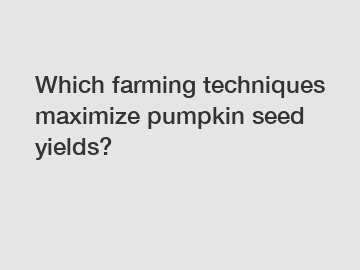Which farming techniques maximize pumpkin seed yields?
Which Farming Techniques Maximize Pumpkin Seed Yields?
Pumpkins are not only associated with Halloween decorations and delicious pies; they are also a rich source of nutritious pumpkin seeds. These seeds are packed with essential vitamins, minerals, and antioxidants, making them a valuable commodity in the market. For farmers looking to maximize their pumpkin seed yields, employing effective farming techniques is crucial. In this article, we will explore some of the best practices for growing pumpkins and maximizing their seed yields.
Choosing the Right Varieties.

Selecting the right pumpkin variety is the first step towards maximizing seed yields. Some pumpkin varieties are specifically bred for their seed production capabilities, such as "Kakai" or "Lady Godiva." These varieties are known for their high seed to flesh ratio, ensuring a bountiful harvest of seeds. It is advisable to consult with local agricultural experts or seed suppliers to determine the best pumpkin varieties that thrive in your specific climate and soil conditions.
Soil Preparation and Fertilization.
Pumpkin plants require well-drained soil rich in organic matter to thrive. It is recommended to prepare the soil in advance by incorporating compost or well-rotted manure. This will help improve soil structure, aeration, and water retention capabilities. Additionally, supplying an appropriate balance of macronutrients such as nitrogen, phosphorus, and potassium through organic or synthetic fertilizers is essential for optimal seed production. Conducting a soil test can provide valuable information about the nutrient levels and pH balance, allowing farmers to adjust their fertilization plans accordingly.
Optimal Plant Spacing and Proper Pollination.
Proper plant spacing is crucial for maximizing pumpkin seed yields. Crowded plants compete for resources, resulting in stunted growth and reduced seed production. Be sure to allow enough space between plants, typically around 3-6 feet apart, depending on the pumpkin variety. This will ensure adequate airflow and minimize the risk of disease transmission.
Pumpkin plants rely on pollinators, such as bees, to transfer pollen between male and female flowers. To enhance pollination and seed set, it is beneficial to attract pollinators by planting flowers or providing alternative food sources nearby. Additionally, manually transferring pollen between flowers using a small brush or cotton swab can help ensure successful pollination, especially in areas with limited pollinator activity.
Proper Pest and Disease Management.
Protecting pumpkin plants from pests and diseases is essential for maximizing seed yields. Regular scouting and early detection of pests, such as aphids or cucumber beetles, can help in implementing appropriate control measures. Integrated pest management techniques, such as biological controls or judicious use of insecticides, can help minimize pest damage without harming beneficial insects or pollinators.
Diseases, such as powdery mildew or downy mildew, can significantly impact pumpkin plant health and seed production. Regularly monitoring plants for signs of disease and promptly treating affected plants with appropriate fungicides can help mitigate disease spread and ensure healthy seed development.
Harvesting and Seed Extraction.
Knowing when to harvest pumpkins is crucial for maximizing seed quality and yields. Pumpkins should be left in the field until fully matured, indicated by a hard rind and dried stem. Once harvested, it is essential to handle pumpkins carefully to avoid any damage to the seeds. To extract the seeds, cut the pumpkin open and scoop out the seeds, then rinse and dry them thoroughly before storage.
In conclusion, maximizing pumpkin seed yields requires a combination of appropriate variety selection, soil preparation, fertilization, optimal plant spacing, proper pollination, pest and disease management, as well as correct harvesting and seed extraction techniques. By implementing these farming practices, farmers can ensure a successful pumpkin harvest and maximize the production of nutritious and valuable pumpkin seeds.
For queries or further assistance on maximizing pumpkin seed yields, please feel free to contact us.
Contact us to discuss your requirements of Forage Sorghum Seed For Sale, cabbage yellow inside, tomato seeds wholesale supplier. Our experienced sales team can help you identify the options that best suit your needs.

Comments